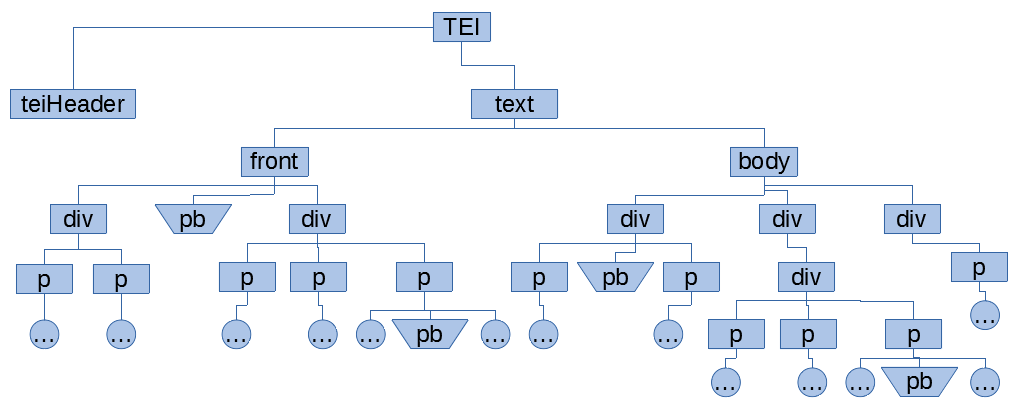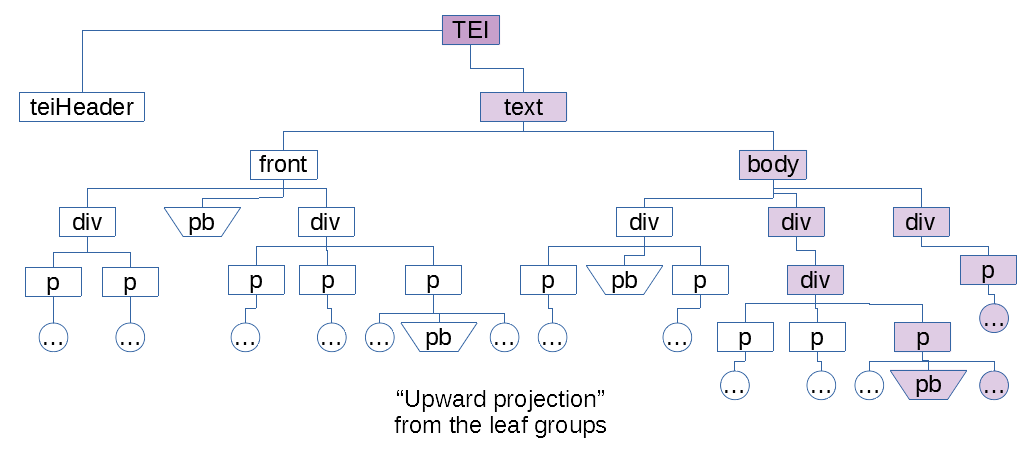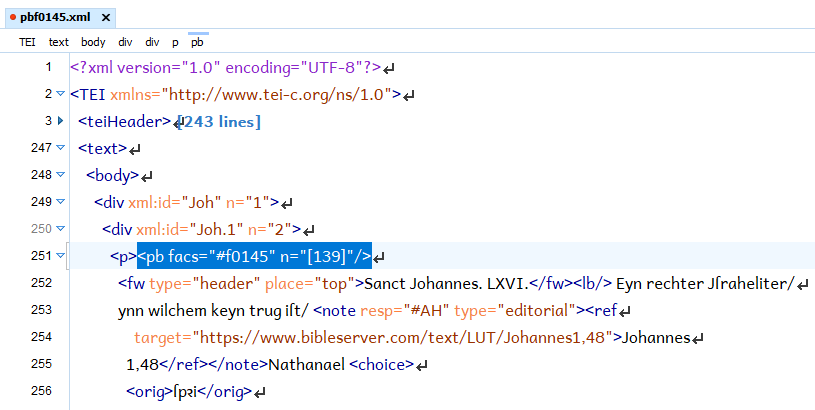Splitting XML Documents at Milestone Elements
Using the XSLT Upward Projection Method
Gerrit Imsieke (@gimsieke), le-tex publishing services (@letexml)

Problems addressed / Applications
- Splitting TEI documents at page breaks
- Put Two-Column Regions into Separate XSL-FO Blocks
- Split at Line Breaks, Excluding Footnotes, List Items, etc.
Also:
- Performance analysis
- Streamability?
- Support arbitrary XML vocabularies (dynamic XPath evaluation)
Eliot Kimber’s FO Block Splitting Woes
DITA OT Day 2018 video (~2:30–4:25), xsl-list post

Geert Borman’s Split-at-Page-Break Woes
“breaking up XML on page break element”
(Geert’s 2014-07-04 XSL Mailing list post)
An “overlapping markup” problem (page division vs. document hierarchy)
Test Document for Splitting at Page Breaks
Martin Luther’s translation of the New Testament into German (1522), TEI P5 XML from Deutsches Textarchiv

Luther’s New Testament as TEI XML
452 pb milestone elements at varying depths
<pbs>
<pb path="/TEI/text/body/div/div/p/pb" count="238"/>
<pb path="/TEI/text/body/div/div/pb" count="91"/>
<pb path="/TEI/text/body/pb" count="52"/>
<pb path="/TEI/text/body/div/pb" count="47"/>
<pb path="/TEI/text/front/pb" count="11"/>
<pb path="/TEI/text/body/div/p/pb" count="10"/>
<pb path="/TEI/text/front/div/p/pb" count="3"/>
</pbs>Luther’s New Testament as TEI XML

Simplified/Abridged Tree View

The XSLT Upward Projection Method

The XSLT Upward Projection Method

Process /TEI in split mode
with a tunneled $restricted-to parameter

(omitting xsl:result-document here for brevity)
The “Conditional Identity Template”

Group 1

Group 2

Group 3

Group 4

Group 5

Splitting Result

The teiHeader would be missing…
…if it weren’t for this template:

The other applications
FO block splitting
Nested grouping (group-starting-with for <two-col-start>,
group-ending-with for <two-col-end>)
Split at line breaks
Avoid splitting at line breaks in embedded list items or footnotes by
- modifying the leaf selection XPath to treat lists and footnotes as leaf-like
- switching back from
splitto#defaultmode when processing list item / footnote content
Performance Measurements
Luther’s 1522 New Testament translation:
- Number of
pbelements: 452 - Number of leaf nodes: 77,649
Hypothesis:
- Performance depends linearly on doc size (node count)
- and maybe on number of splitting points
~ Linear Dependence on Doc Size
Dependence on Number of Splitting Points?
- Created docs with the first 10, 50, 100, 200, 300, 375 pages
- using a modified upward projection XSLT
Surprise: 1st 10 pages: milliseconds, 1st 375 pages: minutes
⇒ Need to measure dependence on chunk size at constant doc length
Dependence on Number of Chunks at Constant Doc Length
Repeatedly removing every other pb results in fewer chunks
Dependence on Chunk Size at Constant Doc Length
Profiling
Culprit: Conditional Identity Template
When chunk length grows…
- …the conditional identity template is called slightly fewer times
- …however, each invocation takes significantly longer
- resulting in (for chunk sizes > 5000 leaves) linear dependence of running time on chunk size
- Still, certain dependence on the number of splitting points for smaller chunks
Remedies
The number of Conditional Identity Template invocations cannot be reduced
Pass generated IDs instead of nodes, compare
generate-id() = $restricted-to instead of exists(. intersect $restricted-to)
⇒ 20-fold acceleration for large chunks
Streaming
No. Michael Kay wrote in 2014:
“... the real problem is that the logic is going down to descendants, then up to their ancestors, and then down again, and that's intrinsically not processing nodes in document order, which is a precondition for streaming.”
Even if it were feasible, the scaling with chunk size would be detrimental.
Dynamic XPath Evaluation
Can we have a configurable splitter for JATS, DocBook, TEI, HTML etc.?
- Yes, works well!
- No prohibitive performance penalty (runs 1.5 to 2 times as long as bespoke stylesheets)
- Best delivered as XSLT 3.0 packages with a
finalentry template andprivateinternal templates
XSLT Pays Off!



